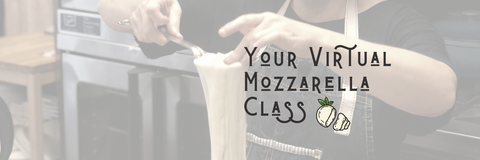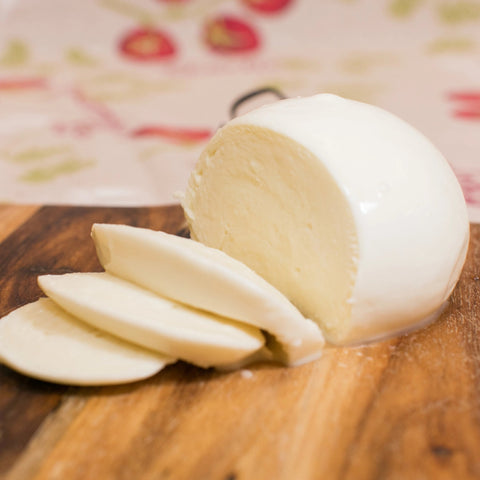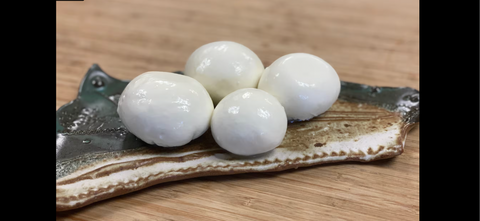Welcome!
Thank you so much for your purchase of our Virtual Mozzarella Class - we're excited to share our passion with you! Below you'll find information on what you will need for the class along with your class video. Happy Stretching!About our Mozzarella
Real cultures and quality milk from family-owned dairy farms are what make our curd so special. As with all of our cheeses, our mozzarella curd is naturally fermented, made with NO vinegar or citric acid. This process creates unsurpassed flavor and texture!
How much of a taste difference should you expect? The cultures turn what is normally a bland, milky cheese into a cheese that’s structured, buttery, with tang that hits you on the sides of your tongue. Our chef customers tell us that it a refreshing and enlightening experience in a world full of bland mozzarella. One even called it life changing. We think they are right.
Get Ready to Stretch!
For troubleshooting tips & FAQs, see the section at the bottom of the page.
Your shipment includes:
- Our handmade, cultured mozzarella curd, shipped frozen (store in the freezer upon arrival). When you're ready to take the class, take out of the freezer and put in a bowl of cool water on the countertop to thaw.
What you will need:
- 2.5 Tbsp. Sea Salt or Kosher Salt
- Approximately 1 gallon of 190° water (using a programmable kettle, or a pot of water on the stove just below boiling)
- Large spoon or paddle (metal or wood)
- 1 large bowl for stretching
- Colander/strainer over a large bowl
- Container of cold water for storage of your finished product (and for cooling off your hands!)
Ready to start?
You can find your class video below - feel free to watch it as many times as you would like! Owner and mozzarella expert Rynn Caputo will teach you all about mozzarella, then lead you through two stretching demonstrations before we finish with a 'stretchalong' at the end. When we are done, you'll have the freshest, most delicious mozzarella you've ever tasted!
If we've made you a stretching pro and want to order more curd (or any of our other cheeses), use coupon code BACKAGAIN10 for 10% off!
FAQs
Don't see your question answered here? Contact UsA shipment confirmation will be sent to the email provided during checkout and will contain a FedEx tracking number. You can access up-to-date information on the location of your package by visiting the FedEx website.
The curd will be shipped to you on dry ice (it's ok if it's slightly thawed upon arrival) and should be stored in the freezer when it arrives. It will need to be thawed before using (either in the refrigerator overnight or in a bowl of cold water on the countertop). As this is a naturally fermented product, once thawed, it should be used the same day for best stretching results. (upon thawing, the fermentation process continues and could alter the outcome of your stretching.)
Fresh mozzarella is best enjoyed the day it’s made! You can store it in water for up to 24 hours, where it will be fantastic in all fresh applications like Caprese Salad. After the 24 hours, remove it from the water and wrap tightly in plastic - the cheese will dry out a little, but at that point would be perfect for pizza, grilled cheese, or baked into a pasta dish like lasagna! Each pound of curd yields about a pound of finished cheese.
They are the solids that remain after the milk is coagulated and the whey is removed. Curd simply means “unfinished cheese.” In cheddar, for example, it would mean that the curds have not been pressed or aged. In the case of mozzarella it means that the curds have not yet been stretched.
This means we make our cheeses in the traditional way, using cultures - or bacteria - to start a natural fermentation process. This is different from the industrial cheesemakers who use vinegar or citric acid to coagulate the milk to make it appear to look like cheese (thereby leaving a high level of lactose in the cheese).
Yes, all of our cheeses are pasteurized at a low temperature to preserve the quality and natural flora of the milk as much as possible. By federal law any cheese aged less than 60 days must be pasteurized.
Burrata is in the mozzarella ‘family’ - it is a freshly stretched pouch of fresh mozzarella, stuffed with stracciatella, which is torn strands of mozzarella soaked in salted heavy cream. The pouch is then cinched closed at the top. It is a specialty of the Puglia region of Italy, but has become famous all across Italy and quite popular in the U.S.! Click here for a video of one of our cheesemakers creating a recipe where he makes burrata!
See the question above about stretching within the first 24 hours. If you only want to stretch half of the curd, that’s fine. The rest of the curd may not stretch if you keep it too long, but would still be fine for crumbling onto a pizza or baking into a pasta dish.
Again, we recommend enjoying your fresh mozzarella within a day of making it, but you can certainly freeze it if needed. At this point it would be best for baking in a lasagna or using on pizza - any melting application vs. eating it fresh.
Troubleshooting Tips
My curds were partially thawed or warm when I received them. That’s ok! As a fermented product, the curds are essentially shelf stable. For more information on this, read here.
The curds are not coming together after I add the hot water - no ‘strings’ are forming. There are two possible causes for this:
1. You may have too much water in the bowl. You want to just cover the curds with the hot water - if they have too much room to swim around, they won’t meet up with each other. Your water is not hot enough.
2. Pour off as much of what you have in the bowl as possible, and add another dose of 190° water to just cover the curds.
I’m not getting the ‘waterfall’ stretch to come together. Similar to the above issue, you probably just need more (or hotter) water. Pour off some of the water and give it another shot of that 190° water. If you get a tear or hole in your ‘waterfall’, just return the cheese to the bowl of water to warm up a bit & try again. You can add a little more hot water if the bowl is cooling off too much.



